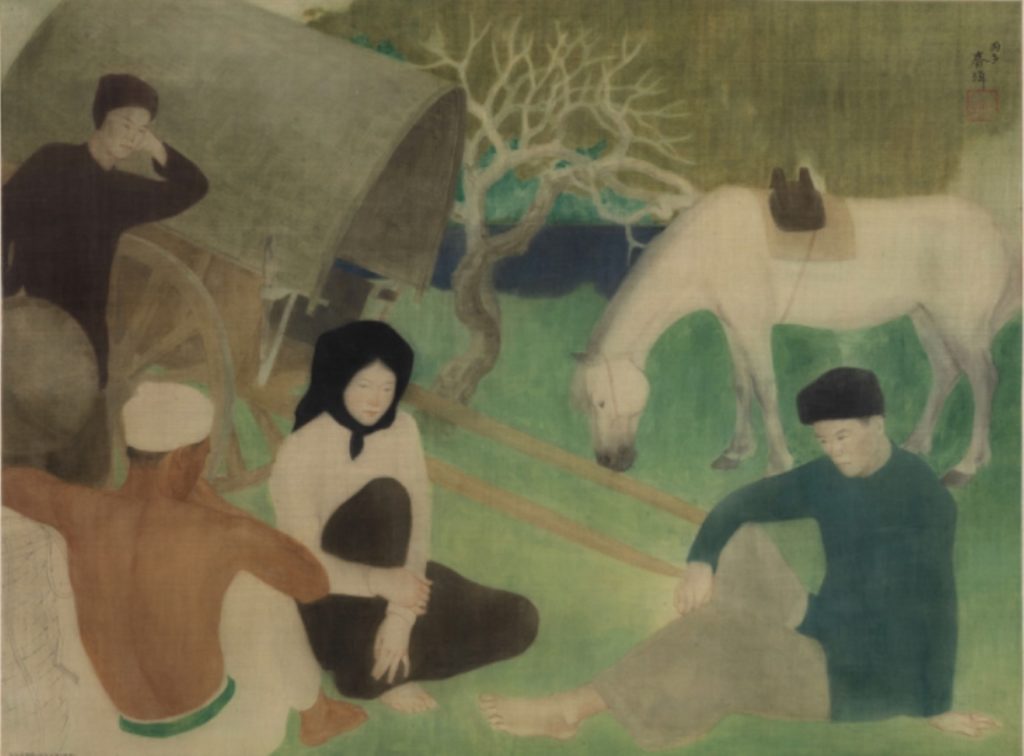“Le Repos”, 1936 – Luong Xuan Nhi or the ambiguous messenger
Luong Xuan Nhi certainly was one of the most honoured painters in Vietnam, and entered the Hanoi School of Fine Arts in 1932 in the cohort of the seventh class.
In the previous year in 1931, the Colonial Exhibition in Paris opened to great acclaim, highlighting the works of his predecessors, graduates or students. The exhibition welcomed 8 million visitors including 1 million foreigners, was universally lauded and praised in the press and was appreciated (and bought) by several collectors. Le Pho, Nguyen Phan Chanh, Mai Trung Thu, Vu Cao Dam, amongst others who exhibited there, had already successfully gained a strong following.
From 1932 to 1937, Luong Xuan Nhi was in his class, the most outstanding student and the awards dutifully followed: the SADEAI (Society for the Encouragement of Annamite Art and Industry) awarded him a silver medal in 1935, a gold medal in 1936 and a ‘Special Prize’ in 1937.
That same year, 86 of his paintings on silk were selected for the International Exhibition of Arts and Techniques of Paris. Prior to this, no other Vietnamese painter had ever been promoted to this extent by the French authorities. The 1937 exhibition, which Le Pho was appointed as the director for the Indochinese section – was held in a different context to the 1931 exhibition. Progress must exceed prestige at a time when universal questioning was needed. The 1930s were marked by a worldwide upheaval in political, economic, social and cultural models, and colonial Vietnam was no exception to the rule.

In 1930, the nationalist mutiny in Yen Bay and the Nghê An riots inaugurated a decade of profound change. In France, the election of the Front Populaire in June 1936 modified France’s vision and ambition. For Vietnam, an amnesty decreed by the colonial power on August 27, 1936 freed many revolutionary leaders who resumed their struggle. Strikes broke out everywhere and much more, an inquiring commission embodied by Justin Godard was designated to go to Saigon. Its verdict was very critical: “the formidable work accomplished by France in Indochina is a fiction”.
To better understand the current lot presented here, this context must be first mentioned. Luong Xuan Nhi synthesized all the questioning going on at the time. The booklet titled The Art Schools of Indochina, was published in Hanoi in 1937 by the General Government of Indochina during the Universal Exhibition in Paris. This helped him promote his realistic subjects. This promotion not only confirmed his talent but also instrumentalized it. France had to disengage and Vietnamese independence became a possibility the French wanted to accelerate.

To be precise, in the booklet, seven paintings were illustrated: two Tran Van Can, one Le Yen, one falsely attributed to Le Yen and three Luong Xuan Nhi paintings. In addition to Le Repos (Resting) , the other two works presented in the booklet are La Jonque (Junkboat) and the Jeune Marchand de Thé (The Tea Seller). Popular subjects to depict a simple and rural Vietnam. There was no illustration of the beautiful elegant city girls in ao dai that he also favoured as painting subjects at the time.

Le Repos (Resting) could be viewed as a manifesto of the time. The four characters (one woman, three men); the rural landscape; the horse and the cart, all describe a certain realism that the phantasmagorical tree and the blue of the water relativize together. The protagonists of the work are simple, peaceful people whose faces oscillate between being at rest and a sense of fatalism. There is no urban elegance depicted but a rural solemnity. None of them have individual poses but instead form a group solidarity, and the abundant black ink and the typical velvety gouache together create a scene that bends towards the centre of the painting. One of the recurring themes of the Tu Luc Van Doan (Autonomous Literary Group) , which was very influential at the time, is illustrated in the painting: the rural landscape, the worker, the simple masses that must be honoured and helped.
In those years the great journeys are being prepared both geographically and ideologically. Some will leave for the West (France) without really looking back, others, more numerous, will turn to nationalism. All however, will advocate independence.
Later, Luong Xuan Nhi, the messenger for the French, became the messenger of the Northern regime, one of the quasi-officials of the regime.
Ambiguity of the message or of the messenger?
Jean-François Hubert